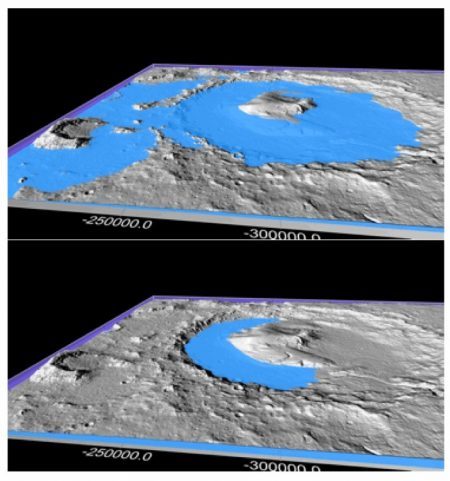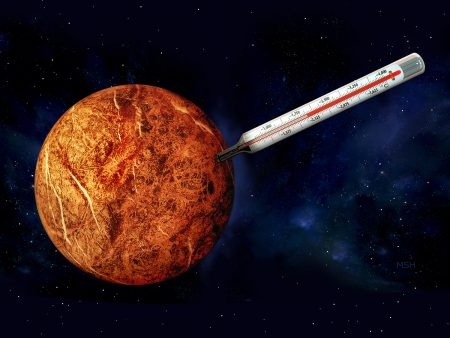December 6, 2016 – In the latest revelations about Mars in the past researchers at Penn State University have modeled the planet’s climate showing that atmospheric carbon dioxide (CO2) created conditions for habitability lasting as long as 10 million years. Is that long enough for life to have evolved?
The model is based on evidence of the existence of water trapped in ice on Mars today. We see the polar ice caps but the ice we don’t see is buried in subsurface deposits similar to the Lake Superior-sized one recently discovered by Mars Reconnaissance Orbiter. The history of that water can be seen in places like Gale Crater where dry stream beds are evident. Some of Mars valleys and canyons appear to have been carved by water and not small amounts. We’re talking about water that could only have come from rain and meters of it.
Could meteor strikes have unleashed the water? Or how about volcanic eruptions? The Penn State researchers don’t believe that either of these is responsible for the evidence we see on the planet today. States Jim Kasting, Professor of Geosciences, “We think Mars had to be warm for millions to tens of millions of years, and the impact hypothesis can keep it warm for thousands of years…….In terms of water, we need millions of meters of rainfall, and they (previous studies) can get hundreds of meters.”
Instead the hypothesis states that CO2, the dominant gas in the Martian atmosphere today, was once even more prominent in a thicker atmosphere creating a greenhouse effect. The source of the CO2, emissions from beneath the crust, similar to what we know happened here on Earth. Although today it is difficult to see evidence of continental plates on Mars caused by interior tectonic flows in the planet’s mantle, the Penn State team believes that this is the most likely explanation for the water-eroded features, some as deep and wide as the Colorado River’s many canyons, and the amount of ice that lies buried beneath the surface. It took 16 million years on Earth to carve the Colorado River’s Grand Canyon. A comparable or greater amount of time, therefore, is a likely explanation for what we see on Mars today.
The presence of larger amounts of CO2 combined with hydrogen can explain the visible evidence. The greenhouse effect produced would have melted the ice on Mars sitting at the outer perimeter of what is considered the habitable zone of our Solar System. The CO2 and hydrogen would have combined along with the ice melt resulting in significant rainfall, enough to create a watery surface with lots of rivers, lakes and oceans lasting many millions of years. The CO2 would have made the rain acidic and the carbon within it would eventually have become stored in the ground. The proof for this hypothesis may lie meters underground in carbonate rocks. Drilling would yield the smoking gun. Would these conditions over millions of year have been sufficient for life to emerge on Mars? That evidence too may lie below the Martian surface.

In a separate study here on Earth, habitability and habitable zones is being called into question. Many astronomers are no longer convinced that the Goldilocks Zone, the location of a planet where conditions are not too cold, not too hot and just right, is the predeterminer for biology to appear. Planetary scientists like Colin Goldblatt, University of Victoria, believe that life could exist before a planet’s conditions appear habitable and that its presence could create habitability over time.
Goldblatt proposes that higher concentrations of CO2 in the atmosphere could keep a planet relatively warm making it habitable. On Earth carbon has played a key temperature control role throughout the planet’s geological history. David Crisp of the Jet Propulsion Laboratory in Pasadena, California, points out that Earth’s atmosphere some 2.5 billion years ago contained CO2 and other greenhouse gases in much greater concentrations than today. Without the presence of these gases Earth would have been in a global ice age with all of its liquid water frozen out. But that was not the case. The greenhouse effect created free water vapour in the atmosphere leading to significant rain which scrubbed the atmosphere of much of its carbon over time depositing it first in ocean water and eventually in carbonate rocks which today are largely stored in the Earth’s crust. Eventually the atmosphere cooled and as continental plates moved around they created volcanic hot zones with eruptions that restored the CO2 into the air. This, states Goldblatt, is Earth’s natural geochemical balancing act.
In his paper’s conclusion Goldblatt states, “Were Earth to have only water in its atmosphere, it would today exist perilously close to both the inner and outer bounds of the conventionally defined habitable zone…..Expanding the habitable zone requires other gases in the atmosphere.” He observes that “the boundaries of the climate states are determined by atmospheric physics” and that “life….has entered the business of controlling the boundaries.” So habitability and inhabitants appear inseparable.
What is so interesting about Goldblatt’s evidence for habitability and inhabitants is how closely it resembles what Penn State researchers see on Mars. On Earth life emerged within the parameter of geochemical cycles. It may be the same on Mars. Goldblatt tells us that habitability is not confined to Goldilocks parameters and needs to be redefined based on atmospheric geochemistry.
Add to this that life may not be bound to one molecule found here on Earth, deoxyribonucleic acid. As we search for evidence of life on future missions to Mars and elsewhere within the Solar System, we have no certainty that we will even recognize it as life when we pass by it. Just to illustrate how far our thinking has gone beyond Goldilocks Zones and DNA, exo-biologists contemplate the existence of life on places like the Jovian moon, Europa, the interior of Ceres, or Saturn’s moon, Enceladus. Some even speculate life could exist on Titan with its thick protective nitrogen atmosphere and evidence of hydrocarbon rainfall, rivers and lakes.

















